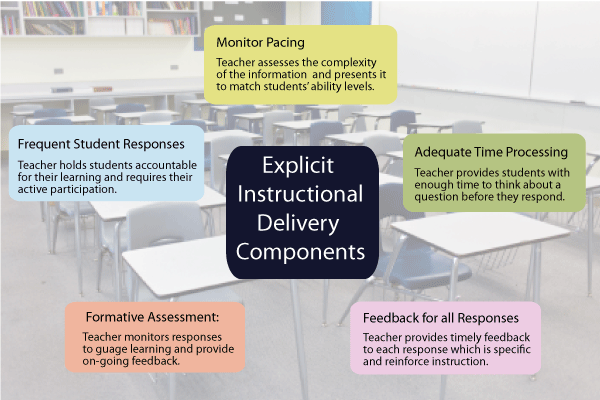Explicit Instruction
"If you put a plant in a jar, it will take the shape of the jar. But if you allow the plant to grow freely, twenty jars might not be able to hold it." –Duke University Coach Mike Krzyzewski
Explicit or direct instruction is a methodology for providing students with the structure that they need to become independent learners. Through this methodology instruction shifts from the teacher delivering the lesson to the students taking responsibility for the learning. Explicit instruction begins with the teacher directing students towards achieving specific learning outcomes. The teacher then explains the concepts using think alouds, modeling and other strategies. Once students understand the concepts, they are provided with multiple opportunities to demonstrate the competencies through guided practice. In this way the teacher will gradually release more of the learning to the students.
Explicit instruction requires the teacher to balance several delivery components that add structure to the learning.

To implement explicit instruction you should consider the following.
- Set the Tone for Learning: Create a comfortable classroom environment that supports a structured approach for learning. Establish protocols and procedures that students can easily follow and consider how to keep students socially, academically, and intellectually engaged. Look for opportunities to tap into students’ background knowledge about the content or skill that is being taught.
- Articulate Learning Objectives: It is essential for students to understand why they are learning and what they are expected to know, understand, and be able to do by the end of the lesson. Teachers must ensure that objectives and directions for learning activities are visible and are relayed in clear, kid-friendly language.
- Model: It is important for teachers to model behaviors and skills so that students can learn concepts and demonstrate competencies. For example, if one of the objectives is to create a complete sentence with a subject and a predicate, the teacher should model how to use a noun and a verb phrase to create a complete sentence.
- Continuously Monitor Students’ Learning: The purpose of explicit instruction is to gradually release more responsibility to students. As this occurs, a teacher must formatively assess, supervise, and continuously check in with students as they work together and independently to meet the learning objectives and goals.
To be effective, explicit instruction requires a teacher to know his or her students and be able to respond to each one's individual learning needs. It involves implementing highly structured lessons and providing immediate feedback on students’ progress. Through formative assessment, teachers should be reflective and review the effectiveness of the instruction and make modifications as necessary. The ultimate goal is to remove the supports and create independent learners.
